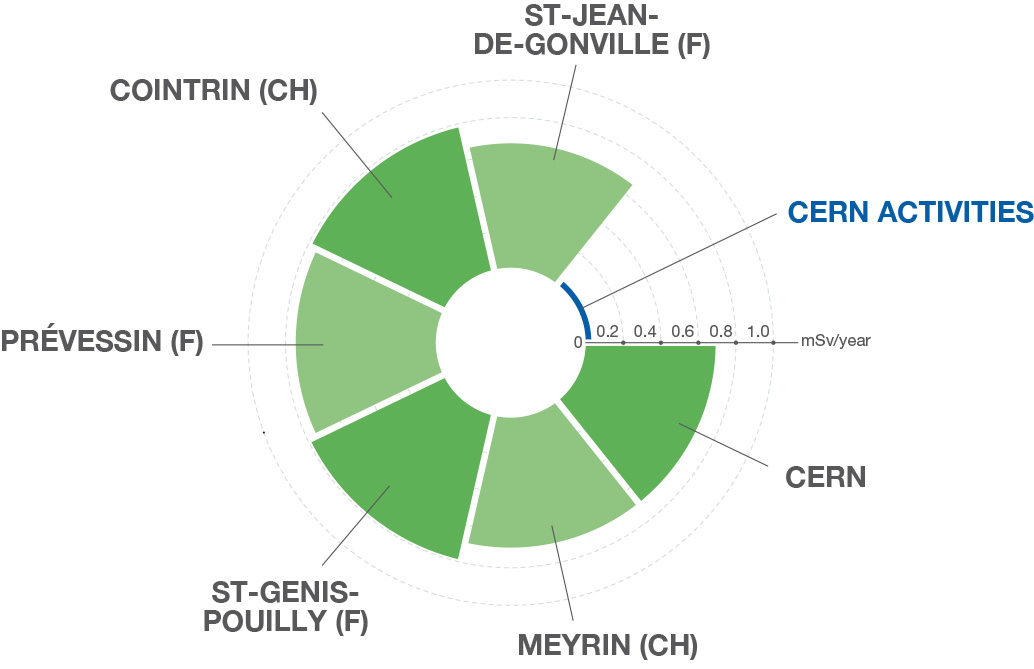 |
|
|
NATURAL SOURCES OF IONISING RADIATION AT CERN AND IN NEIGHBOURING COMMUNITIES.The typical dose of natural sources (green) measured at several places neighbouring CERN sites, compared to the dose induced by CERN activities (blue). |
At CERN, ionising radiation is produced by the collision of particle beams with matter. CERN’s unique facilities require innovative approaches to minimising the exposure of workers, the public and the environment, making CERN one of the recognised leaders in this field. CERN’s radiation protection is in line with best practice in Europe. Keeping CERN at the forefront in this area is a priority for the Organization.
RADIATION – A NATURAL PHENOMENON
Radiation is all around us. It comes from the Earth and from space. It is present in our food, and we receive controlled doses in medical examinations such as X-rays. Industrial and research facilities can also generate ionising radiation.
The European Council sets the annual dose limit for public exposure at 1 milliSievert, mSv. CERN commits to limit its part to no more than 0.3 mSv per year. The actual dose to any member of the public living in the immediate vicinity of CERN due to the Organization’s activities is much lower: below 0.02 mSv per year. This is less than the exposure received from cosmic radiation coming from space on a flight from Geneva to New York.
RESPONSIBLE REPORTING
CERN adheres and contributes to internationally recognised radiation protection and safety systems. Following the precautionary principle, the Organization continuously optimises facilities and practices to minimise its radiological impact. A tripartite agreement, signed with the Host States in 2010 and steered by the HSE Unit in collaboration with CERN Departments, ensures transparency and alignment with best practice in radiation protection and safety. CERN reports quarterly on radioactivity measurements in the local environment to Swiss and French authorities.
CERN’s legal framework for radiation protection sets out basic principles along with rules and procedures for protecting CERN personnel, the public and the environment. These rules adhere to the internationally-recognised As Low As Reasonably Achievable, ALARA, principle, and include job planning, training, radioactive waste management, and management of radioactive materials and sources.
State-of-the-art monitoring
Ionising radiation is constantly monitored inside and outside the CERN perimeter. Every year, the Organization carries out thousands of analyses of air, ground, vegetal and water samples from the surrounding environment and employs over 100 state-of-the-art monitoring stations to ensure that emissions of ionising radiation remain below 3% of those arising from natural sources. CERN’s methods, and the scope of its monitoring program, are reviewed by Host State authorities, which also carry out their own monitoring around CERN installations.
IN FOCUS
Eric Zelnio is Deputy Head of Division at the Lyon office of the French Nuclear Safety Authority, ASN. Nicolas Stritt is Head of the Research facilities and nuclear medicine section at the Swiss Federal Office of Public Health, OFSP.
— How do you judge CERN's commitment to radiation protection?
EZ: CERN's commitment to radiation protection is seen to be significant. The production of detailed and technically substantiated reports makes it possible to document compliance with the defined limits, to evaluate the doses to reference populations, and to suggest areas for optimisation.
— What is the importance of the tripartite agreement?
NS: The tripartite agreement is important since as an international organisation, CERN is outside the normal regime of authorisations and supervision defined in national laws. The tripartite agreement provides a framework for replacing this regime. It has improved cooperation and coordination between CERN and the Host States, harmonised procedures and improved radiation protection.
Learn more
Questions regarding this report may be addressed to Environment.report@cern.ch.

